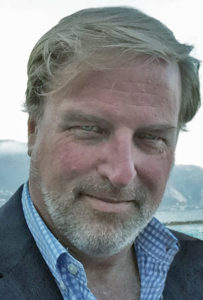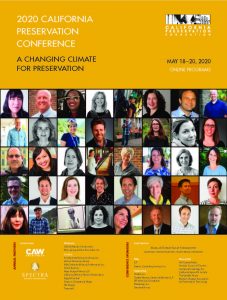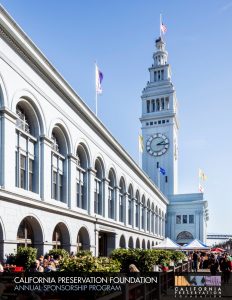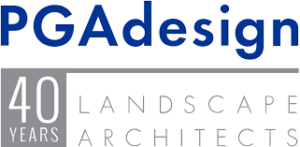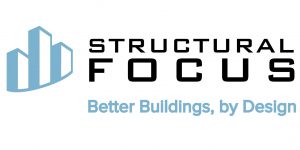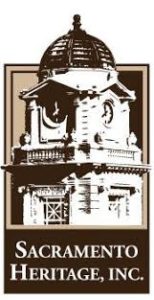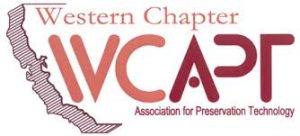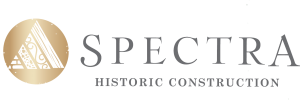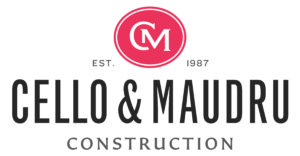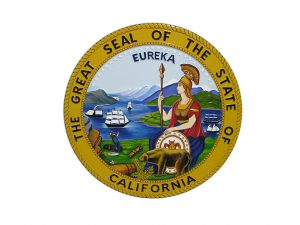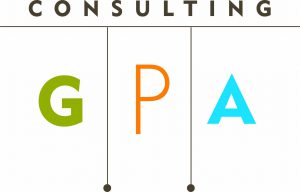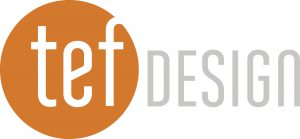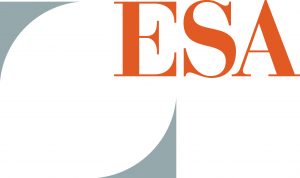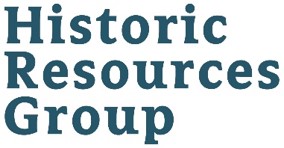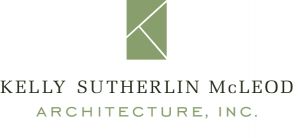

Registration & Details
Details
- $210 non-members | $150 members
- $75 per day | $75 students
Continuing education
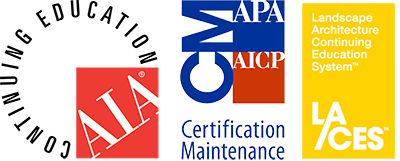 All live programs qualify for continuing education units through the AIA, AICP, ASLA and CLG. All attendees can take advantage of our continuing education program at no additional cost.
All live programs qualify for continuing education units through the AIA, AICP, ASLA and CLG. All attendees can take advantage of our continuing education program at no additional cost.
- Many sessions qualify for Health, Safety, and Welfare units (HSW)
- Some sessions will qualify for AICP legal and ethics credits
Program Book
To view the program, you download the file below or click here.
Register securely online through CPF’s Website
For More Information
- Call us at 415-495-0349
- Email at cpf@californiapreservation.org
Tiki Time & Wicked Sacramento Free Tickets HERE
Evening Events.
You may register for the conference for free access to our evening virtual happy hour parties, or you may register just for the evening events “Wicked Sacramento” and “Tiki Time.” LINK to the REGISTRATION page here to join via Zoom or catch us on our Facebook @ca_preservation to see the programs LIVE.
Monday, May 18, 2020 - Online Programs
Monday, 05/18/2020, 09:00 AM – 10:00 AM
Plenary Speaker: Anthony Flint (Author, Journalist, Lincoln Institute of Land Policy)
We are happy to announce Anthony Flint as our keynote speaker. His presentation will focus on “The Age of the Overlapping Crisis: Managing Housing, Preservation, Equity, and the Environment.” Flint is a noted author and journalist, Senior Fellow at the Lincoln Institute of Land Policy, urban design critic for the Boston Globe, and correspondent for CityLab.
Monday, 05/18/2020, 10:30 AM – 11:30 AM
Recent CEQA Case Law Update and Advanced CEQA Q&A
Don’t miss the latest version of the standing-room-only CEQA session from last year’s conference in Palm Springs. This session begins with a review of recent court decisions governing historic resources under CEQA and the court’s interpretation of cultural resource cases in 2020. A moderated panel discussion follows with a series of case studies, both inside a court and out, using CEQA as a catalyst to create Win-Win projects. Bring your questions and challenges during our extended Q&A, discussing Impacts, Exemptions, Mitigations, Advocacy Groups, and the Secretary of the Interior’s Standards CEQA Exemption. This will be an advanced-level session, ideal for cultural resource professionals and planners.
Moderator: Susan Lassell, Senior Manager of Cultural Resources, ICF International; Speakers: Susan Brandt-Hawley, Esq., Brandt-Hawley Law Group; Brian Turner, Senior Field Officer & Public Lands Attorney, National Trust for Historic Preservation; Sean de Courcy, Associate Preservation Planner, Community Development Department, City of Sacramento
Monday, 05/18/2020, 10:30 AM – 11:30 AM
Seismic Resilience: Two Materials, Two Divergent Spaces
Preservation projects at the Napa Courthouse and at the Presidio in San Francisco will be discussed in relation to conservation and context. Practioners will discuss the advantages and challenges of using FRCM (fabric reinforced cementitious matrix), a thinner and more porous material than gunnite or carbon fiber wrap, to repair the earthquake-damaged walls of the Napa Courthouse in one of the first applications of this material in California. A second case study focuses on the long-term conservation treatment campaign for a terra cotta-tile basin, dating from the early 1800s, located at the Presidio. This archaeological feature, discovered in a watershed, is exposed to dramatic seasonal changes. To preserve the structure, the project team is exploring options including reburial and modifications to both the basin and the surrounding landscape.
Moderator: Erik Kneer, Structural Engineer, Holmes Structures; Speakers: Luke Wilson, SE, LEED AP, Associate Principal, ZFA Structural Engineers; Elizabeth Graux, AIA, Project Manager, TreanorHL; Nancy Goldenberg, AIA, LEED AP, Assoc. DBIA, Principal, TreanorHL
Monday, 05/18/2020, 12:00 PM – 1:00 PM
Wildland Fire Exposure: Protection Strategies for Buildings
Historic buildings are often more vulnerable to wildland fire exposure due to issues of material, design, and location. The wood construction has a low moisture content due to years of exposure, facilitating ignition and accelerating flame spread, and the lack of “defensible space,” can be a challenge to preservation in crisis situations. In addition, the remote location of historic buildings can result in a delayed fire department response. These factors, coupled with restrictions on the ability to modify facades and roofing, put the designer between the hammer and the anvil in search of practical solutions. This session will showcase innovative methods to protect buildings in place and plan for emergency response. The session will close with a review of construction materials for fire resistance and application of an historic structures report towards outlining efficient fire suppression systems. You will learn how to use creative solutions for maintaining historic fabric while managing fire risk.
Speakers: Ione Stiegler, FAIA, Principal Historic Preservation Architect, IS Architecture; Kathleen Kennedy, State Historian II, California State Parks
Monday, 05/18/2020, 12:00 PM – 1:00 PM
Learning from the Future: Students Share their Knowledge
Students in Heritage Conservation, Public History, Historic Preservation, and related fields are often exploring cutting-edge or out-of-the-box preservation methods in their studies. Each year, the California Preservation Foundation and its Higher Education Committee select exemplary students from a pool of submitted proposals at universities and colleges in California, Washington, and Oregon. Each student is allotted up to 25 minutes to talk about their research and findings. Topics could range from materials conservation to community engagement, survey methods, documentation, cultural landscapes, and more. This is an opportunity to learn from the best emerging minds in preservation on the West Coast.
This year’s presenters include:
- Jackson Loop, University of Southern California, “‘It’s important to remember what started it’: Conserving Sites and Stories of Racial Violence in Los Angeles, 1943-1992”
- Kelsey Kaline, University of Southern California, “Mobilizing Heritage for Resilient Cities”
Monday, 05/18/2020, 1:30 PM – 2:30 PM
Successful Hybrid Preservation-Resilience Approaches for Flood Mitigation
Flooding, sea level rise, and increased precipitation are increasing the frequency and severity of coastal, riverine, and urban hazards. Conventional flood mitigation measures often create significant preservation challenges, and guidance often conflicts with established preservation guidelines. In this session, participants will learn about sources of flood risk and projected climate change scenarios; identify strategies to assess vulnerabilities; examine mitigation measures; and explore flood mitigation in the context of historic preservation. We will also discuss the actions being taken to address this problem and the role of regulatory changes. Hazards that impact historic transportation infrastructure will be addressed with examples of hybrid preservation-resilience approaches that achieve more successful outcomes, paired with an exploration of adaptive strategies that consider cultural resources while achieving resilience goals.
Speakers: Matthew Gilbertson, Sr. Consulting Engineer, Simpson Gumpertz & Heger; Zoey Craun, Associate Project Consultant, Simpson Gumpertz & Heger; January Tavel, Sr. Architectural Historian, ICF; Tait Elder, Sr. Archaeologist, ICF
Monday, 05/18/2020, 1:30 PM – 2:30 PM
An Innovative Public-Private Partnership: The Cooper-Molera Adobe
The Cooper-Molera Adobe represents the rich history and complex origins of the state of California and contributes to the Monterey Old Town National Historic Landmark District. Dating from 1827, the 2.4-acre site includes adobe residences, an adobe warehouse and corner store, and a multi-building barn complex, all surrounded by an original adobe wall. An innovative public-private partnership paired the National Trust for Historic Preservation with a developer through a shared-use agreement. The two groups revised the traditional house museum model, combining historic interpretation with appropriate commercial uses through rehabilitation, adaptive reuse, and sensitive infill. This comprehensive presentation will include the National Trust, the developer, the historic architect and representatives from the City of Monterey discussing the complexities of making an historic site culturally, environmentally and sustainable in today’s economic climate.
Moderator: Naomi Miroglio, Principal, Architectural Resources Group; Speakers: Douglas Wiele, Founding Partner, Foothill Partners, Inc. Real Estate; Katherine Malone-France, Chief Preservation Officer, National Trust for Historic Preservation; Kimberly Cole, Community Development Director, City of Monterey
Monday, 05/18/2020, 3:00 PM – 4:00 PM
Climate Resilience Roundtable: A Peer-to-Peer Learning Activity
This panel identifies ways to engage, educate, and empower local officials to pass innovative legislation that addresses resilience, adaptation, and disaster response. Three presentations will be followed by a peer-to-peer learning exercise where participants will explore questions regarding why the preservation community should engage in resilience planning, what are the best tools, effective timing, resources for support, hazard mitigation, emergency response, and other questions and data gaps. The session will conclude with an opportunity for the participants to break out into small groups where they can ask technical specialists help in trouble shooting real-world challenges. Participants are encouraged to bring examples of issues they are facing, or anticipate tackling, at the intersection of climate resilience and heritage preservation.
Moderator and Speaker: Lisa Craig, Executive Director, Lodi Historical Society; Speakers: Thomas Hendrickson, Senior Managing Consultant, Climate Change, ICF; Brandy Bones, Senior Director, Disaster Management, ICF; January Tavel, Architectural Historian, ICF; Richard Starzak, Vice President, Historic Preservation, ICF
Monday, 05/18/2020, 3:00 PM – 4:00 PM
“Differpatibility:” Interpreting SOI Standard #9
“Differpatibility” is a design balancing act of subjective interpretation; a union of apparent opposites. No. 9 states that the “new work will be differentiated from the old” and not destroy historicity, but somehow also be compatible in scale, materials, and features. This session will seek better definitions for new addition construction, alterations, and infill between historic structures and within historic districts or neighborhoods.
Are proposed designs more likely to be approved because there is a dramatic difference in scale, material, massing, form, texture and ideology? Is a “compatible” definition actually the reverse of that method? A broad survey of examples from Sacramento and statewide, successful or not, will illustrate case studies with comments from members of the audience welcome.
Moderator: Taylor Louden, AIA, GTL | HA Historical Architecture; Speakers: Jon Marshack, Past Chair, City of Sacramento Preservation Commission; Scott Watson, Historic Preservation Officer, Community & Economic Development Department, City of Riverside; Sally Zarnowitz, AIA, Planning Manager, Town of Los Gatos
Tuesday, May 19, 2020 - Online Programs
Tuesday, 05/19/2020, 9:00 AM – 10:00 AM
Advancing Racial and Social Equity: Strategies for the Historic Preservation Field
This session will explore strategies for centering racial and social equity in historic preservation, addressing how the recognition and safeguarding of intangible cultural heritage can advance equity within our communities. The speakers will discuss their work with marginalized groups to sustain their cultural assets, reflect on delineating the historical significance of resources associated with communities of color, share their work on the San Francisco Planning Department’s Racial and Social Equity Action Plan, and discuss ways to recruit and train a diverse group of historic preservation practitioners. Bring your questions and ideas to this strategic session focused on practical solutions.
Moderator: Shelley Caltagirone, Senior Planner, Cultural Heritage Specialist, San Francisco Planning Department; Speakers: Dillon Delvo, Executive Director, Little Manila Rising; Eliza Tudor, Executive Director, Nevada County Arts Council; Erica Schultz, Senior Associate, Architectural Resources Group; Trudi Sandmeier, Director of Graduate Programs in Heritage Conservation, USC Architecture
Tuesday, 05/19/2020, 9:00 AM – 10:00 AM
A Tale of Two Cities: The Failure of Preservation in Stockton
In 1969 the City of Stockton introduced a series of preservation initiatives. By the year 2000, the city was well on its way to being a model of historic preservation, with a well-written preservation ordinance, two established historic districts, a two-tiered historic listing system, and five major historic asset surveys completed, covering approximately 60% of the old city center. Twenty years after, the story has turned to tragedy. Through arson, neglect, and disinterest by the city government, far more structures have been lost than protected, preserved or even designated as historic. The panel will consider the history of Stockton’s failed preservation program and discuss how Stockton can change direction and realize its cultural and historic potential.
Moderator: Jackie Whitelam, Chair, City of Sacramento Preservation Commission; Speakers: Robert Holtzer, Senior Member and Past Chair of the Stockton Cultural Heritage Board; Wesley Swanson, PhD, Professor of History at San Joaquin Delta College, Chair Stockton Cultural Heritage Board; Rudi Blondia, Board Member, Downtown Stockton Alliance; Linda Derivi, Stockton-based Architect and Founder of Save Old Stockton; Steve Castellanos, Stockton-based Architect and Founder of Save Old Stockton; Wes Rhea, CEO, Visit Stockton; Phillip Merlo, Director of Education, San Joaquin Historical Society.
Tuesday, 05/19/2020, 10:30 AM – 11:30 AM
Complexities in Community Engagement: Three Asian American case studies in Los Angeles
Community engagement and education is crucial in garnering support for the nomination of historic sites to official lists, a process complicated by negotiations between multiple groups and interests. This panel focuses on the complex challenges revealed across diverse Asian American communities in Los Angeles. Three landmark nomination cases will be discussed: the Filipino Christian Church, Japanese Hospital, and Tokio Florist. Each of these efforts was backed by a core group of Asian American preservationists, but variances in the process impacted the research methodology, the scale and scope of public outreach, and the resulting nominations.
Moderator: Michelle Magalong, President/Presidential Postdoctoral Fellow, APIAHiP/University of Maryland; Speakers: Kristen Hayashi, Collections Manager, Japanese American National Museum; Rosalind Sagara, Neighborhood Outreach Coordinator, Los Angeles Conservancy
Tuesday, 05/19/2020, 10:30 AM – 11:30 AM
Reinvesting in Railroad Infrastructure to Revitalize Downtowns: Two Case Studies
The growth of railroad systems played a significant role in the development patterns of California in the 19th Century, with communities establishing their center at railway stops. But downtown Main Streets struggled with economic decline as development shifted to the suburbs during the rise of automobile use. Recent projects are taking the movement back to its beginnings, with reinvestment in historic railway infrastructure providing an effective anchor for community identity and increased downtown densification. In this session we will explore two case studies of this type: the relocation and rehabilitation of the historic Livermore Depot in Livermore, CA; and the ongoing development of Historic Folsom Station in Folsom, CA.
Moderator: Sarah E. Brummett, Senior Associate and Preservation Specialist, Page & Turnbull, San Francisco, California; Speakers: Michael Smiley, Principal, CITYdesignworks, Nevada City, California; Debbie Bell, Management Analyst II, Public Works Department, City of Livermore, California; Jerry Bernau, President and CEO, Bernau Development Corporation, Folsom, California
Tuesday, 05/19/2020, 12:00 PM – 1:00 PM
Lunch with the SHPO: Julianne Polanco
Tuesday, 05/19/2020, 1:30 PM – 2:30 PM
Using Augmented Reality to Make the Intangible Tangible
The intersection between the humanities and technology is fraught with challenges and often approached with skepticism. Digital documentation exposes new, and remote, audiences to historic resources with “re-creations” – in exact detail – of landscapes and structures. We will discuss what purpose preservation plays in a world that is increasingly negotiated on screen and explore how practitioners can engage the public using the latest new technologies to interpret challenging, difficult, or otherwise absent historic fabric in significant buildings. This cross-disciplinary panel of experts will approach the topic of historic preservation and augmented reality through discussion and case studies that utilize 3D-documentation technologies, wearable or connected interactive devices, and cutting edge methods that enhance visitor interactions with historic sites and boost real-time experiences.
Moderator
Brittani Orona, Environmental Justice and Tribal Affairs Specialist, State of California; Speakers: Mary Clark, PhD, Chief Executive Offficer, Agents of Discovery; Joel Krupa, PhD, Chief Administrative Officer, Agents of Discovery, Inc.; Astrid Reed, Director, AVA Inclusivity; Gregg Leonard, Co-Founder, AVA Inclusivity
Tuesday, 05/19/2020, 1:30 PM – 2:30 PM
Revitalizing California’s Main Street Program
California was an early participant in the Main Street Program, a nationwide movement of communities committed to bringing renewed economic vitality and improved quality of life to downtown. State funding for this program dwindled in the 1990s, but recent efforts – thanks to a partnership between a cohort of local Main Street communities and the National Main Street Center – have resulted in an exciting new era in California. This session will describe the past, present, and future state of the California Main Street Program – from its early beginnings to its fresh new start. Speakers will explore the goals, challenges and successes of the early program; share some exciting new developments with Main Street California over the past year; and discuss where the program is headed from here.
Moderator: Ruth Todd, Principal, Page & Turnbull; Speakers: Keith Kjelstrom, former Director of the California Main Street Program and New Mexico Main Street Program; Amanda Elliott, Senior Program Officer and Director of California Programs, National Main Street Center; Gabriel Martin, Economic Development Manager, City of Coachella
Tuesday, 05/19/2020, 5 PM – 6:30 PM
Wicked Sacramento – Virtual Happy Hour!
This talk tells the stories of historic places mentioned in William Burg’s latest book, Wicked Sacramento, accompanied by photos provided by the Center for Sacramento History and Sacramento Public Library. Set in the West End, a neighborhood mostly demolished by redevelopment in the 1960s, only a handful of buildings survive to tell the stories of Sacramento’s early 20th century pleasure palaces and vice dens. Case studies include:
- The apartment of the murderers of society madam Cherry de Saint Maurice
- The Opera Dance Hall, whose curtained booths were reportedly used for semi-private sexual encounters
- The home of Black entrepreneur, Progressive political organizer, and gambler Grant Cross
- The last surviving speakeasy of boxer turned bootlegger Ancil Hoffman
- Legendary jazz venue the Clayton Club, located inside a hotel built to honor one of Sacramento’s most powerful women
- An African-American owned restaurant/nightclub that became a memorial to Japanese-American soldiers
Exploration of these sites reveals a more complex story than the oversimplified tales of urban blight and criminality frequently presented as Sacramento’s urban history. Was the greatest crime committed in the West End the theft of a diverse neighborhood’s legacy, in the name of racism and higher property values?
Moderator: William Burg, Board of Trustees, Sacramento Heritage
Wednesday, May 20, 2020 - Online Programs
Wednesday, 05/20/2020, 9:00 AM – 10:00 AM
Resurrecting the Past: Preservation of a 118-year-old stained glass inverted dome in Downtown Oakland
Nzilani Glass Conservation recently conserved a 10-foot diameter, inverted stained glass dome in the historic Christian Science church in Oakland, California. The church was recently purchased by Resurrection Oakland Church (ResOak), who contracted Nzilani to preserve the 118 year-old piece in their West Oakland Studio after an initial assessment identified unstable previous repairs.
The cornerstone was laid in 1900 and the building was opened and dedicated on January 5, 1902 as the First Church of Christ. It was sold to a clothing retailer in the late 2000’s and then was held up by zoning issues. It then lay unoccupied for two years until purchased by ResOak in 2019.
This materials-focused presentation will cover issues including improper protective coverings, which hastened its deterioration plus considerations specific to conserving leaded glass that has multiple complex curves, engineering upgrades and creation of a completely new steel structural support. Additionally, it will demonstrate how project management by the core stained glass team facilitated work across disciplines, from traditional artistic metalsmiths to engineers who had never been involved in a preservation project.
Speaker: Ariana Makau, AIC Professional Associate, Board Member and Health & Safety Chair of Stained Glass Association of America, President & Principal Conservator, Nzilani Glass Conservation
Wednesday, 05/20/2020, 9:00 AM – 10:00 AM
Where Form Based Code and Preservation Intersect
This dynamic interdisciplinary presentation introduces and applies form-based code methodologies and preservation planning principles (based on the Secretary of the Interior’s Standards) to several project scenarios as viewed from the perspective of professionals in preservation architecture, form-based code planning, and an economist. The speakers will include brief introductions to the Standards and Form Based Code concepts and then lead a discussion of sample projects including additions to historic buildings, constructing a tall building next to a historic resource, infill issues, and considerations of adapting form based code in respect to the existing character of a historic district or neighborhood.
Moderator and Speaker: Michael Garavaglia, President, Garavaglia Architecture, Inc.; Speakers: Matt Kowta, Principal, BAE Urban Economics; Tony Perez, Director of Form-Based Coding, Opticos Design
Wednesday, 05/20/2020, 10:30 AM – 11:30 AM
From Prison to Possibility: The Preston School of Industry as Economic Driver
The adaptive reuse and preservation of the 300-acre Preston School of Industry has aided a small community’s effort to become a tourism destination. This session will highlight the non-profit Preston Castle’s Foundation’s stewardship of the property and the completion of a National Register nomination that addressed both the significance of the site and also acknowledged a complicated social history of the youth prison system. The potential of the property was revealed through economic feasibility studies and the identification of additional rehabilitation funding. The productive relationship between the community of Ione and tourism interests, paired with the identification of future economic and recognition opportunities, will be explored within this discussion.
Moderator: Mike Garavaglia, Principal, Garavaglia Architecture; Speakers: Karl Knobelauch, President, Preston Castle Foundation; Jamie Armstrong, Executive Director, Amador County Chamber of Commerce
Wednesday, 05/20/2020, 10:30 AM – 11:30 AM
Farmsteads: Reviving Agricultural Properties for the Public
As our economy evolves and communities grow, family farmsteads, dairies and ranches are no longer dominant fixtures of rural communities. Yet many municipalities strive to retain a legacy of the life-blood which initiated settlement of these regions. This session explores how several municipalities, organizations and planners in the Sacramento area are shaping agricultural legacies into new communities, such as Wakamatsu Farm, Nicolaus Dairy, and Fiddyment Farm. Brief presentations will be followed by a panel discussion to share the aims, development and execution of distinct plans to resuscitate an agricultural property for public benefit. The panel will examine active programming of historic properties as a means of engaging audiences in the context of the people and their land, with a focus that looks beyond simple interpretative exhibits or the house-museum model.
Moderator: Melisa Gaudreau, Associate Principal, Page & Turnbull; Speakers: Elena DeLacy, Executive Director, American River Conservancy; Vyomini Upadhyay, Associate Civil Engineer, Sacramento Area Sewer District; Tara Gee, Park Planning & Development Superintendent, City of Roseville; Melissa Ruth, Associate, Callander Associates
Wednesday, 05/18/2020, 12:00 PM – 1:00 PM
Lunch Speaker: Anthea Hartig, PhD, Director, Smithsonian Institution’s National Museum
Wednesday, 05/20/2020, 1:30 PM – 2:30 PM
The Diverse Legacy of California’s First National Heritage Area
The Sacramento-San Joaquin Delta supplies water for the state and produces food for the nation, while also serving as a recreational haven. Taking a trip here is a step back in time, with historic towns, ferries, and bridges dotting the region. This idyllic landscape, however, is not without threats. Accelerating sea level rise could further exacerbate flood risks and recurring efforts to increase water exports threaten the region’s economic and cultural vitality. Yet the Delta’s greatest threat may be its invisibility.
Unlike other efforts centered around water conveyance and ecological restoration, the recently established Sacramento-San Joaquin Delta National Heritage Area (NHA) focuses on the Delta’s cultural and historical resources. This session will discuss the NHA concept, spotlight model NHAs, and discuss the past, present, and future of the Delta NHA.
Moderator: Stephen Mikesell, Owner Mikesell Historical, Mikesell Historical Consulting; Speakers: Linda Stonier, Regional Coordinator, National Heritage Areas Program, National Park Service; Blake Roberts, Member, Delta Protection Commission; Alex Westhoff, Preservation Tech Specialist, City of San Francisco
Wednesday, 05/20/2020, 1:30 PM – 2:30 PM
Design Roundtable: Infill & Form-Based Code Review Process
This roundtable session deconstructs the design emphasis portion of CEQA while addressing successful approaches in historic communities. A temporary “Board” of five, representing a mix of opinions and judgments, will review a project to better define the terms “compatibility,” and “differentiation,” when proposing in-fill and additions in historic areas. The board will articulate applied differences in review criteria between disparate styles, such as Modernism and Colonial Revivals of the 20th century, and discuss the best proactive approaches for positive community engagement and agency responses.
A discussion of Sacramento’s newly developed Historic District Design Standards Plan, that provides guidelines for ADU’s, massing and setbacks, will be included, and will end with comments from the current chair of Sacramento’s Preservation Commission and Planners at the front line of the review process.
Moderator: Taylor Louden, AIA, Historic Architect, GTL | HA Historical Architecture; Speakers: Sean de Courcy, Associate Preservation Planner, Community Development Department, City of Sacramento; Jackie Whitelam, President, City of Sacramento Preservation Commission; Erin Gettis, Historic Preservation Officer, County of Riverside; Andrew Wolfram, Architect & Past President, City of San Francisco Historic Preservation Commission
Wednesday, 05/20/2020, 5 PM – 6:30 PM
Tiki Time! – Virtual Happy Hour
Sponsorship
The California Preservation Conference has become an essential gathering for California’s historic preservation community and offers a unique promotional opportunity.
Become a Conference Sponsor
Download the sponsorship materials here, or by clicking the image below.
Sponsorship Program
Firms can support as a Conference Sponsor or an Annual Sponsor. Conference Sponsors gain maximum exposure for the duration of the Conference advertising period. Annual Sponsors gain exposure and benefits throughout the year.
Track Titles
Weathering the Storm: Resilient Planning and Design
As the impact of natural and man-made hazards increase every year, so do the threats to our historic resources. In addition to the ever-present risk of earthquakes, we face an increasing risk of fire, flood, and sea-level rise from a warming climate. These hazards threaten our historic resources across the state and present preservationists with new challenges for maintaining our significant cultural and historic assets. This track will explore case studies and best practices for resilient urban planning, fortified/hardened design, and the protection of our most vulnerable historic resources.
Sustaining Our Intangible Cultural Heritage
Intangible cultural heritage is an important factor in maintaining cultural diversity in the face of growing globalization. An understanding of the intangible cultural heritage of different California communities helps with intercultural dialogue and encourages mutual respect for other ways of life. In this track, you will learn that it also includes traditions or living expressions inherited from our ancestors and passed on to our descendants, such as oral traditions; performing arts; social practices; rituals; festive events; knowledge and practices concerning nature and the universe; or the knowledge and skills to produce traditional crafts.
Infill and Affordable Housing: Developing the Best Fit for Historic Neighborhoods
How can preservationists be part of the solution to the housing crisis while protecting our historic properties? Housing advocates and no/slow-growth advocates have squared off in an effort to address the needed changes in a manner that communities can tolerate. In the middle of the fray may lie historic and culturally significant properties that help establish the look and feel of a community – helping create a sense of place. We will discuss policies and programs that attempt to resolve the affordability issue, and alternate means of increasing housing diversity, including densification, adaptive reuse, and various planning tools.
The Legacy and Future of Rural and Agricultural Heritage in California
Much of California’s history is rooted both in its agricultural abundance and its water, or lack thereof. Property types, distinct to the American west, evolved to meet the tandem needs of water management and agricultural production. California’s growing population and persistent housing shortages (from the 1920s to the present), make rural and agricultural lands vulnerable to development pressures.
This track will explore comprehensive approaches for documenting these ubiquitous resources, as well as grass-roots preservation efforts, especially in areas that lack political will for additional regulations. We will discuss successful large- and small-scale case studies and how the legacy of the state’s rural and agriculture history is an asset to communities.
How Preservation Helps Main Street
To remain sustainable, communities must have healthy commercial districts, be they a traditional Main Street in a town, the central business district of a city, or neighborhood-serving shops and restaurants. This track will focus on the role of preservation-based economic development projects in achieving the revitalization of such core places. With a focus on Northern California, this track will provide an update on California’s Main Street Program, case studies of successful projects and panel discussions as to the challenges in bringing such projects to fruition.

